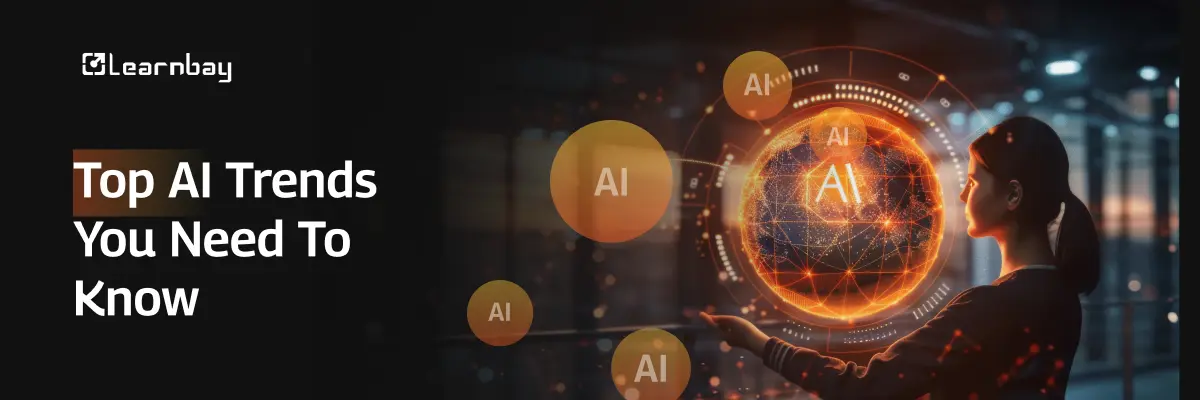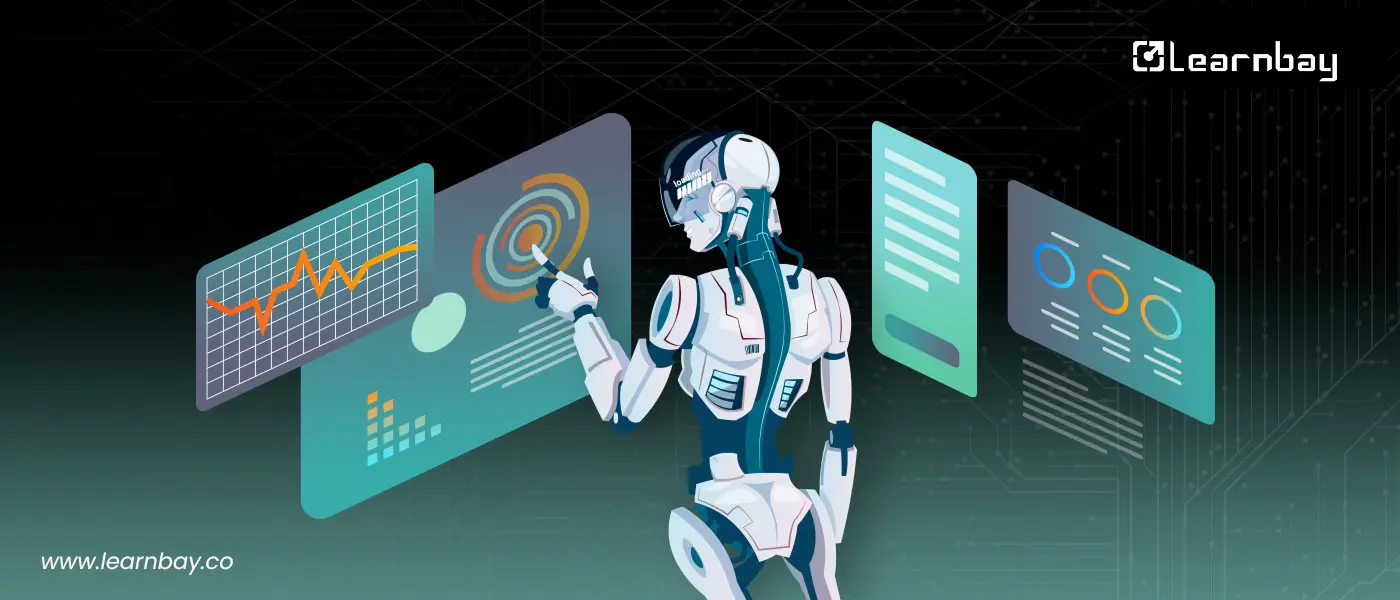
Know the AI Trends Set to Shake up the World This Year
The willingness of businesses to invest in Artificial Intelligence (AI) technology confirms the rising state of AI in the upcoming years. As the technology evolves into bigger and better applications, more investments may occur, resulting in an AI expansion beyond belief.
Businesses must be prepared with the latest AI trends to ride the wave of technological advancements in the next few years. Indeed, learning and adaptability are the keys to success in 2026 and beyond.
We have already witnessed the latest trends in artificial intelligence, as examples in ChatGPT, DALL-E-2 , and many others that came out last year. This year also brings the possibility of advancements in the field of AI. Emerging AI trends in 2026 leap forward with applications like the Metaverse and chatbots. The potential of such technologies in solving problems occurring in the real world can be observed.
Recent trends in artificial intelligence suggest a push toward the execution of AI programs, which will be focused on addressing some critical issues. Such issues include security and fraud, environmental problems, medical care, and more. These programs will confront world issues straight up rather than just increase profits for businesses.
Without taking much time, let's discuss the top AI trends 2026 that will change the landscape of digital technology.
Emerging AI Trends That You Must Know in 2026
Trend 1: Technological advancements in NLP
Advanced natural language processing (NLP) is one of the most eye-catching trends in AI.
NLP is used in many applications, such as AI chatbots, virtual assistants, and language translation software.
As the market for these applications increases, NLP will also boost its usage in other areas. More companies are likely to realize NLP's potential this year as OpenAI's GPT-3 makes considerable strides in the market. In fact, we already have the latest version of the technology, GPT-4.5.
The NLP market is supposed to be valued at 357 billion dollars by 2030. The rise of AI models suggests that the technology is moving towards a bright future with speech recognition, sentiment analysis, and conversational AI.
NLP will continue to innovate and improve ways for machines to analyze text in a human-readable format. Businesses focusing on customer relationship improvement can apply NLP to increase their understanding of consumer behavior, resulting in a net profit.

Trend 2: Innovations in AI search through Generative AI
As soon as ChatGPT was released, it took over the internet by storm, and a horde of consumers began testing its potential. Since then, the tech giants have started racing to develop the next big thing in generative AI. Among the top AI trends in 2026 is the implementation of generative AI in search systems to improve their accuracy.
The recent years have witnessed innovative applications of generative AI. Microsoft has debuted its collaborative AI search engine with Bing, powered by ChatGPT technology. Google has also released Bard and Gemini , updated versions of the AI search engine, to challenge Microsoft's search engine.
These generative AI innovations have introduced a fresh wave of development. Although they are still in their infancy, they are improving upon their previous versions quickly. Many analysts have pointed out glitches and errors they found, which are being worked on, so we can expect to see improvements in the coming months.
Trend 3: AI in healthcare
Artificial Intelligence developments are proven strong weapons in battling the pandemic. Since then, AI has come into the public eye as a critical component in innovating healthcare.
AI and machine learning are accelerating several medical processes in the industry. Many healthcare data scientists believe AI initiatives are critical in providing better solutions.
The latest trends in AI transform tasks like genetic sequencing reports, identifying patients for research studies, scanning handwritten data into an online platform, recording and converting doctor-patient conversations to text notes, etc.
Emerging AI trends are effective in improving operational performance. Hiring platforms powered by AI are popular among clinicians in finding job postings. AI systems for operating on patients are among the technologies getting a boost and assisting hospital staff.

Trend 4: Autonomous AI
AI automation is significantly improving the automotive industry . Autonomous systems such as vehicles, robots, and drones are expected to advance with the help of AI. Technology helps these systems carry out tasks that may be dangerous or difficult for human beings.
AI automation has reshaped the automotive industry with end-to-end safety precautions for passengers. Also, autonomous drones provide help in search and rescue missions, minimizing the chance of human error.
Trending AI projects, such as driverless vehicles, also offer a more personalized experience to the driver by analyzing their moods using voice recognition.
Contrary to the AI trends 2026, however, the autonomous vehicle market is experiencing some bumps in the road.
Apple , which started 'Project Titan' to compete in the autonomous vehicle market, has called it off. Many such AI applications were stopped due to the current technology not being sufficient in implementing the fully autonomous concept.
Trend 5: Ethics Concerning Gen AI
Regulatory policies regarding Gen AI have become a primary concern among individuals and companies. These are rising mainly due to the ethical complications with AI systems, such as ChatGPT. Such tools shows signs of bias and discrimination.
The latest tech innovations consider AI ethics regulation as a top priority. The main issue is the possibly faulty data these systems are being trained on.
Researchers are working on strategies for identifying and managing bias in AI models to solve this issue. The growing awareness of the ethical implications of Gen AI and the need for ethical frameworks and rules is driving the future of AI.
AI ethics tries to address these problems by ensuring the responsible development and usage of technologies like ChatGPT. Apart from it, we may also see some Gen AI laws being put in place. These will regulate companies using or providing AI-powered systems that risk being unethical.
Trend 6: Computer vision
Computer vision is a significant component of AI. It concerns a computer's ability to process image and video data. Systems using computer vision have proven to be more efficient and faster than humans.
One of the top AI trends in 2026 is work automation in several industries. This act of minimizing human interference with automation brings drastic changes.
One such example is the manufacturing sector, which sees a massive decrease in staffing numbers. The lack of a working force will get worse in the upcoming years. That's why computer vision is essential for the industry to thrive. Manufacturers are enhancing the effectiveness and operation of their facilities by utilizing computer vision.
Computer vision systems are among the recent trends in AI. They can monitor every stage of the manufacturing process. One key use of this trend in production is the detection of irregularities. Companies using these systems mostly recorded a positive ROI.
Trend 7: Metaverse
The upcoming few years will be a watershed moment for many businesses in terms of building their worlds within the Metaverse. AI in business operations ensures a more profitable future. It assures major operational shifts for firms that stay aligned with the latest trends.
Most recent trends showcase the usage of AI in the Metaverse. AI can overcome the constraints of AR (Augmented Reality) and VR (Virtual Reality) to build realistic 3D visuals and places.
AI systems have an inherent capacity for progress owing to autonomous learning, which reduces the need for human intervention.
While the dispute over the Metaverse's limits and regulations continues, businesses are actively organizing and assembling it. Regarding this, the combination of large language models with the Internet of Things (IoT) provides the required data and has enabled the construction of digital twins.
Trend 8: Agentic AI
The era of autonomous operations and mult-agent collaboration focuses on Agentic AI. The latest buzzing AI trends bring Agentic AI into the spotlight, creating a space for a collaborative workspace.
Agentic AI introduces multi-agent functioning to work with diverse teams and drive higher productivity. Its integration with Generative AI aims to automate workflows and work independently.
The future of AI inspires data scientists, data analysts, and ML engineers to update their skills and stay competitive. Agentic AI aims to team up with various professionals and industries to enhance work efficiency.
Trend 9: AI in Cybersecurity
The integration of artificial intelligence in cybersecurity introduces new norms of system security. According to reports , over 62% of firms face deepfake attacks, encouraging teams to adopt AI-driven safety measures.
AI uses machine learning algorithms to predict cyber attacks and combat them. It complies with AI ethics and principles to secure internal systems. Hence, cybersecurity experts step forward to master AI models for better efficiency.
Indeed, it is one of the sustainable AI trends 2026, empowering firms to ensure end-to-end security. Firms can adopt AI-driven models to secure their data from threats and build resilience.
Trend 10: Quantum Computing
2026 has been a year of AI transformation due to its seamless integration with various industries. Quantum computing with AI brings a drastic change in data handling practices.
The endless rise of AI models and extensive applications makes data handling challenging. However, experts can master AI concepts with quantum skills to confront the changes.
Quantum computing is a promising AI trend with the ability to tackle massive datasets and drive insightful results.
The Future of AI
The future looks promising as we anticipate a broader applicability for everyday operations of AI-based, user-friendly automated devices. AI trends also correlate with the more significant economic trend of personalization of goods and services.
Constant use of large language models provides all indications for further advancement in the next five years. Businesses must update their functions and talent force accordingly to stay ahead of the curve.
Among the emerging AI trends, Agentic AI is currently trending, encouraging many professionals to upskill. In addition, the integration of Gen AI with diverse industries inspires experts to refine their skills and thrive.
Plus, the future of AI emphasizes that computer vision may be employed along with satellite photography to detect deforestation, prohibited logging, and unauthorized fishing in the rainforests.
This is the right time to invest in these artificial intelligence trends, not only for businesses but also for individuals who can benefit from learning all about the AI trends 2026.
To grab the upcoming opportunities in AI, professionals can upgrade themselves with the Data Science and GenAI Master Certification Program by Learnbay. This will help them remain ahead of the curve by learning under the supervision of skilled mentors. Furthermore, you can develop practical skills through live, real-world applications.
FAQs:
1.What is the next big thing in AI?
The next big thing in AI, as of now, is Agentic AI. It is the latest AI trend that integrates autonomous systems with existing business models. Agentic AI mainly focuses on enriching business efficiency without or with lesser human intervention.
2.What will be the biggest AI adoption challenges in the upcoming years?
Some crucial AI adoption challenges in 2026 and afterwards will be –
• Data security
• Data bias and misinterpretation
• AI talent shortage
• Employee’s resistance
• Unclear business KPIs and ROI
3.What are the key problems AI models can solve?
AI in business operations can solve the following problems –
• Lack of insightful decision-making
• Customer service issues
• Risk prediction
• Fraud detection
• Operational issues
